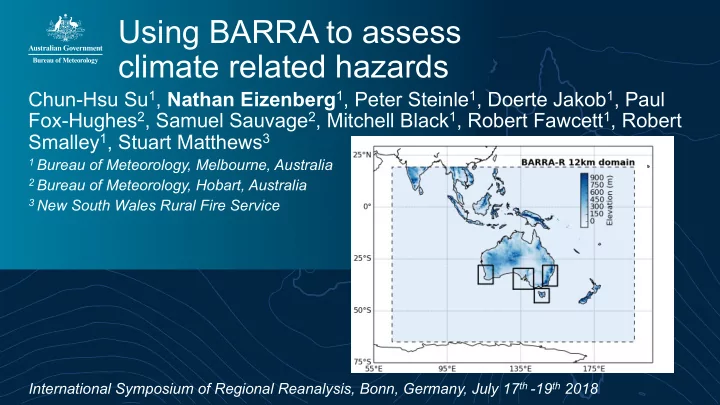

Using BARRA to assess climate related hazards Chun-Hsu Su 1 , Nathan Eizenberg 1 , Peter Steinle 1 , Doerte Jakob 1 , Paul Fox-Hughes 2 , Samuel Sauvage 2 , Mitchell Black 1 , Robert Fawcett 1 , Robert Smalley 1 , Stuart Matthews 3 1 Bureau of Meteorology, Melbourne, Australia 2 Bureau of Meteorology, Hobart, Australia 3 New South Wales Rural Fire Service International Symposium of Regional Reanalysis, Bonn, Germany, July 17 th -19 th 2018
Climate & weather hazards in Australia Lake Hume, 2007 during the Millennium Drought 1996-2010 in South Australia Source: http://www.bom.gov.au/climate/about/ Photo: https://www.flickr.com/photos/suburbanbloke/381634787/
Climate & weather hazards in Australia Source: https://me.me/ Bushfire satellite image Victoria 19 th February 2009 - NASA's Goddard Space Flight Centre, MODIS Rapid Response Team (colour corrected)
Reanalysis-based climate analysis products R Fawcett, R Smalley (BOM) As well as forecasts, the Bureau of Meteorology provides a freely accessible, web based climate analysis explorer for Australian climate and past weather products • BARRA will start to inform national climate monitoring • Regional reanalysis derived climatology • Regional reanalysis to initialise statistical spatial interpolation of observational 'analyses' (right c.f zero- initialised on left)
Fig 4. Composite analysis for rainfall Evolution of climate analysis products using a more sophisticated R Fawcett, R Smalley (BOM) (experimental) statistical interpolation method. In development. Fig 2. Spatial Barnes Fig 3. Composite analysis using analysis (distance combined statistically interpolated weighted statistical anomalies (Fig 2) and thin plate interpolation) of spline-smoothed 3D mean for Australian Climate max surface temp. Current Fig 1. Manually Observation Reference operational analysis technique analysed seasonal Network – Surface Air outlook map for rainfall Temperature (ACORN- September - November SAT) 2010 1989 2000 Fig 5. Reanalysis rainfall map – the future of climate analyses? 1989
Reanalysis in National Fire Danger Ratings System prototype The NFDRS will replace the current system to improve communication , preparedness , response and planning around fire events and bushfire risk in Australia. Reanalysis value • Informing better selection of fire danger rating category thresholds • Providing grid cell 95 th percentile Continuous Haines Index values for 'red flag' warnings within the system • Improved diurnal behaviour of peak fire indexes 95 th percentile daily maximum NFDRS ratings over the reanalysis period (2010-2015) (P F Hughes, S Sauvage & S Matthews in draft July 2018)
Reanalysis in National Fire Danger Ratings System prototype P F Hughes, S Sauvage & S Matthews (draft July 2018) • Hourly reanalysis data distinguishes diurnal behaviour of fire indexes • Mean peak fire season index in the early-mid afternoon (dark blue and yellow) and mid-late morning (cyan and green) (Top) Fire season mean time of max index in UTC. (Inset) Mean time of daily max Continuous Haines index. Note that 12 UTC = 20 AWST = 22 AEST
Reanalysis in bush fire risk planning S Matthews (NSW RFS) BARRA reanalysis used to provide atmosphere and soil conditions for case studies of fire events simulated by fire spread models (Phoenix, Spark, Australis Landgate) The simulation output informs bush fire risk planning and emergency response policy • Fire intensity • Attack mechanism (flames vs embers) • Effect of fuel management on risk Cobbler Road fire simulation comparison Chris Bridge (Bureau of Meteorology)
Conclusions • The Bureau of Meteorology regional reanalysis (BARRA) has exciting value for Australian climate and weather applications • Regional reanalyses (RR) will continue to form the basis for many climate, and weather products at the Bureau in the future • RR climatologies add value to station-based climate analyses • High-resolution RR data are invaluable to fire danger risk analysis (climatologies and conditions) • Sub-daily information is valuable for case-study applications and diurnal behaviour analysis
Thank you Nathan.eizenberg@bom.gov.au Helpdesk.reanalysis@bom.gov.au
References • Bushfire satellite image - NASA's Goddard Space Flight Center, MODIS Rapid Response Team (colour corrected) • Aussie climate http://www.bom.gov.au/climate/about/ • https://me.me/i/you-know-australia-sidangerous-fire-danger-rating-today-code-red-5122568
Recommend
More recommend